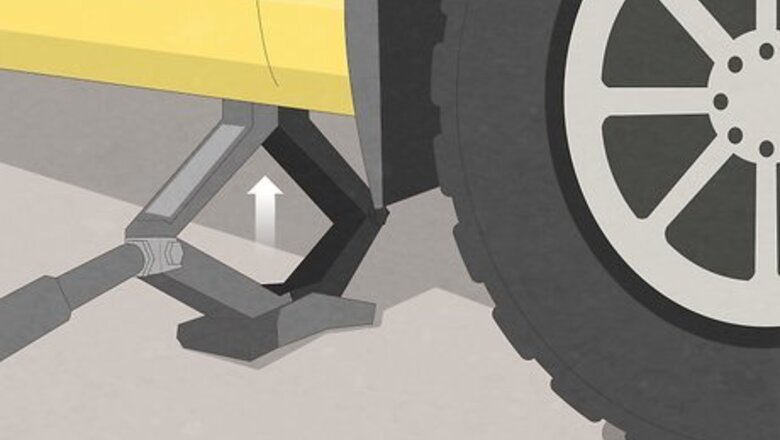
views
- Jack your vehicle up and visually inspect your exhaust line for holes, cracks, loose seams, or black soot on the exterior of the pipes.
- Connect a shop-vac to the tailpipe so it blows air into the system. Hold your hands a few inches away from the exhaust line and feel for air blowing out.
- Spray the exhaust line with soapy water while a shop-vac blows air through the system, and look for spots where bubbles form to locate the leak.
Locating the Exhaust Leak

Jack up your vehicle. Find the jack point on your vehicle’s frame, which is usually at the front, back, or next to one of the tires. Raise your vehicle on a jack and position jack stands underneath the frame to support the weight. After you jack up one side of your vehicle, remove the jack and raise the other side on stands as well. That way, you’ll safely be able to go underneath your vehicle to access the exhaust line. Avoid going underneath your vehicle while it’s only on a jack because it’s not very sturdy and could cause serious injuries if your vehicle slips.
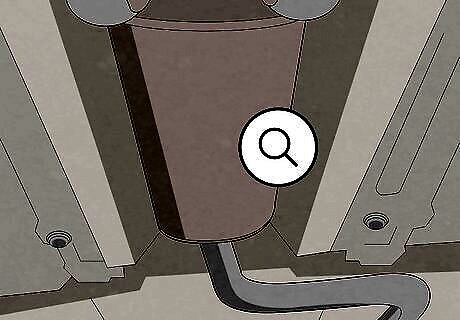
Inspect the exhaust line for noticeable cracks, holes, or soot buildup. Pop open your hood and start your inspection on the exhaust manifold, which is a large metal piece on the side of your engine that connects the cylinders to the rest of the line. Follow the exhaust line from the manifold down through the engine bay to the bottom of your vehicle. If you notice any holes, openings, or black soot coating the outside of any exhaust components, mark the location with a paint pen so you easily locate and repair the leak later on. If your exhaust pipes look rusty, gently squeeze them with pliers to see if they flex or compress. If you notice any movement, then consider replacing them because they may start leaking soon. It’s normal for your muffler, the rectangular piece at the very end of your exhaust line, to have a small hole on one of the ends. This weep hole allows water to escape to prevent rust, so it won’t cause an exhaust leak and doesn’t need to be patched.
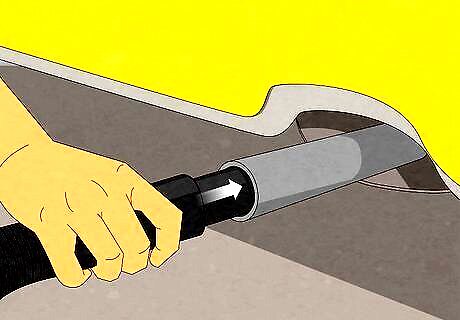
Connect the blower outlet on a shop-vac to your exhaust pipe. Let your vehicle’s exhaust system cool for 30 minutes if you recently drove. Then, take the hose off of your shop-vac and connect it to the machine’s blower outlet, which will force air out instead of sucking it up. Stick the other end of the hose firmly into the end of your exhaust pipe. Turn on your shop-vac so it starts blowing air through your exhaust system. Wrap a towel around the shop-vac’s hose if it doesn’t form a tight seal with your exhaust pipe. Alternatively, seal the seam with duct tape. If your vehicle has 2 exhaust pipes, put the vacuum hose in one pipe and tape a nitrile glove around the second to block it off. Shop-vacs don’t blow a lot of air through your exhaust, so it won’t damage any parts. If you’re still nervous about attaching one to your exhaust line, just plug the tailpipe with a rag and idle your engine to force the air through any leaks.
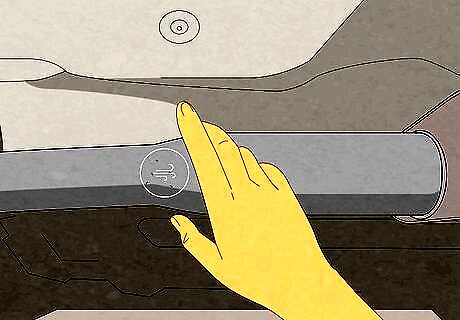
Hold your hand close to the exhaust line to feel for air blowing out. Start near the muffler at the end of your exhaust line and work toward the front of your vehicle. While the shop-vac is running, hold your hands 1–2 inches (2.5–5.1 cm) away from the pipe and move your hands up the line toward the exhaust manifold. If you feel any air blowing out from holes or joints between pipes, mark the leak with a paint pen. If you’re checking for exhaust leaks right after driving, let the pipes cool down completely for about 30 minutes because they can get extremely hot and could cause severe burns. Alternatively, you may be able to hear a hissing or whistling sound of a leak by holding the end of a stethoscope near the exhaust pipe. EXPERT TIP Jason Shackelford Jason Shackelford Auto Technician Jason Shackelford is the Owner of Stingray Auto Repair, a family owned and operated auto repair shop with locations in Seattle and Redmond, Washington. He has over 24 years of experience in auto repair and services, and every single technician on Jason’s team has more than 10 years of experience. Jason Shackelford Jason Shackelford Auto Technician Feeling along exhaust pipes locates air leaks without tools. You can find an exhaust leak using a simple trick — run your hand near, but not touching, the exhaust pipe to feel where air is spurting out. This easy, hands-on method helps locate the leak without needing fancy tools.

Coat your exhaust system with soapy water and look for bubbles. Add water and a few drops of dish soap to a spray bottle and mix them thoroughly. Keep the shop-vac running while it’s connected to your exhaust line. Spray the soapy mixture onto the exhaust manifold where it connects to your engine. Then, work your way down the exhaust line to your muffler to find any remaining leaks. If you see any areas where air blows out from the line and creates visible bubbling, then mark the leaky spot with a paint pen. If you still aren’t able to find any leaks in your exhaust system, take your vehicle to a professional mechanic to diagnose the problem for you.
Exhaust Leak Symptoms

Loud engine noise When there’s a hole or break in your exhaust system before the muffler, you may notice that your vehicle gets louder when you accelerate and quieter as you slow down. Listen for a rhythmic groan or whistling noise coming from under the hood or under your vehicle while your vehicle is running to determine if the system is leaking. When you start your vehicle, you may hear a sound reminiscent of a lawnmower if there’s an exhaust leak.

Reduced gas mileage When exhaust fumes leak before they reach the catalytic converter (a filter near the middle of your exhaust line), electronic sensors get inaccurate readings about how much fuel your engine needs. Your vehicle may then start pulling more fuel to make up for the inaccuracy, so your engine won’t work as efficiently.

Vibrations When exhaust fumes escape through a small hole along the line, it can make rattling vibrations you may feel through your gas pedal, steering wheel, or floorboards. These vibrations are usually more prominent while you’re accelerating and more exhaust is moving through the system.
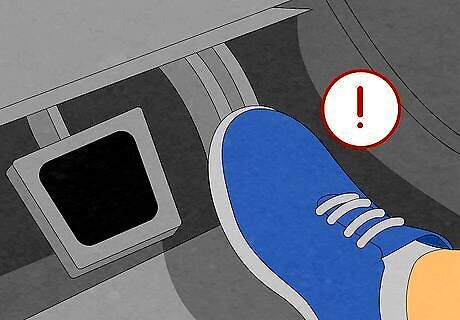
Loss of acceleration When your vehicle leaks from the manifold or anywhere along the exhaust line, your engine may not pull the proper amount of fuel, which could cause clogs or flooding. You may notice your engine feels sluggish when you push down on the gas pedal or that it stutters before accelerating if you’re dealing with a leak. Loss of accelerating power usually gets worse the longer you leave an exhaust leak unfixed.
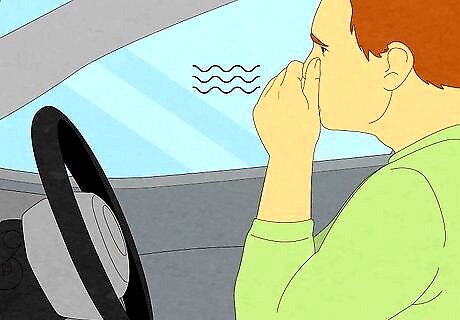
Strong unpleasant odors Exhaust fumes may escape from a leak and get inside the vehicle’s cabin, so you may notice a gasoline or burning smell while you’re driving. If you notice a rotten egg smell while you’re driving, then it may be a sign that your catalytic converter has gone bad.

Lit “Check Engine” light Look on your vehicle’s dashboard for any warning lights about your engine or exhaust system. While there may be multiple reasons why a “Check Engine” light turns on, read the problem code using an OBD reader to determine if the issue is with your exhaust system.
Fixing an Exhaust Leak

Try patching the leak with epoxy exhaust putty. Epoxy putty hardens solid to prevent air from escaping from small holes or seams between exhaust pipes. Because it’s made to work and stay firm at high temperatures, it’s a good budget solution to fix minor problems along your exhaust line. Clean the area surrounding the hole with a wire brush and rubbing alcohol to remove rust and grease. Moisten the exhaust pipe with water. Stir the putty and apply it over the leak with a knife. Press the putty into the hole with the side of your knife to work it deeper. Idle your engine for about 10 minutes so your exhaust pipe warms up and hardens the epoxy putty. Allow the putty to cure for 24 hours before driving so it fully hardens.
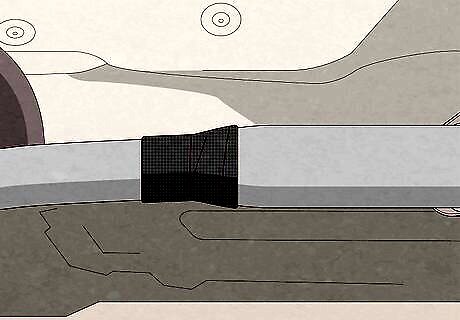
Wrap exhaust tape around damaged pipes. Exhaust tape is a heat-resistant flexible adhesive that works best for wrapping around holes or tears in the middle of your exhaust line. When the exhaust tape heats up, it solidifies and makes a solid airtight connection that stops the leak. Exhaust tape can work as a permanent or temporary solution. Scrape rust and debris off of the exhaust pipe with a wire brush. Submerge the roll of exhaust tape in water for 30–40 seconds to activate it. Squeeze out any excess water. Stick the end of the tape over the hole. Pull the tape as tightly as possible as you wrap it around the damage and overlap it by about 1–2 inches (2.5–5.1 cm). Add 3–4 layers of exhaust tape over the damage to fix the leak. Idle your vehicle for 20–30 minutes so the exhaust line heats up and hardens the tape.

Cut out damaged sections and clamp an exhaust coupler to the line. Clamps connect the ends of pipes to form an airtight seal, but they may also work if you place them around holes in the middle of a line. Clamps are a great alternative for sealing pipes without doing any welding on your exhaust line, so they’re easy to install on your own. Cut the damaged section of the exhaust pipe out with a hand saw or reciprocating saw. Use sandpaper to rough up the surface around the cut ends. Slide an exhaust coupler onto the ends of the pipes so it has a tight fit. Secure exhaust clamps onto the ends of the coupler, and tighten the nuts with a wrench.

Install new gaskets if they’re damaged. Gaskets are seals that sit between your engine and the exhaust manifold as well as between the flanges of your exhaust pipes. Gasket replacements are a little more involved, so take your vehicle to a professional if you don’t feel confident making the repairs on your own. Unscrew the nuts on the exhaust flanges with a wrench. If the nuts are stuck, try spraying them with penetrating fluid and letting them sit for a few minutes. Clean rust and debris off the flange connections with a wire brush. Pry the old donut-shaped gasket off with a flathead screwdriver. Slide the new gasket onto the end of the exhaust flange. Reattach the exhaust flanges and tighten the nuts with your wrench until they’re snug.




















Comments
0 comment